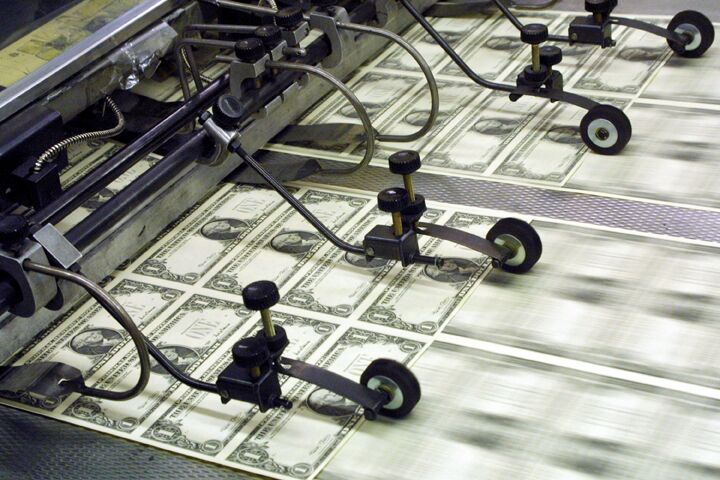
Federal Reserve: Printing Money to Save Banks
The Federal Reserve rode to the rescue again on Tuesday by making even more easy money available to Wall Street’s big bankers and bond dealers. The Fed is clearly starting down the inflationary path; the inevitable result will be a sharply lower U.S. dollar—one that will eventually resemble Zimbabwe’s currency.
The Fed said that a “rapid deterioration” in the inter-bank lending markets impelled it to begin a series of additional cash injections in an effort to prop up the balance sheets of America’s stricken banks. Underlining the severity of the current banking crisis, the Bank of Canada, the Bank of England, the European Central Bank and the Swiss National Bank each joined the Fed’s lead to loan more money to the stricken financial institutions.
The creative new loan program, called tslf (Term Securities Lending Facility), makes it much easier for borrowers to obtain money from the Fed and hold on to it for much longer. Whereas before, banks could only borrow money from the Fed overnight, now they may borrow for up to 28 days. In addition, the new lending program will expand the collateral the banks can use to obtain the loans. The Fed’s new plan actually goes so far as to allow banks to use slumping mortgage-backed securities as collateral—the very type of securities that caused the banking crisis and got the banks into trouble in the first place.
This latest move “was seen as a direct lifeline to investment banks, which previously couldn’t borrow in past Fed liquidity plans,” according to the Associated Press.
But it could also be viewed as the beginning of a full-scale Federal Reserve-sponsored bailout. Peter Dunay, chief investment strategist at Meridian Equity Partners, says that the new deal means the Fed is “basically going to take the bad loans off the banks’ books.”
In other words, “The Fed is saying if you don’t want those mortgages, then give them to us,” confirms Peter Schiff, president of Euro Pacific Capital, an investment firm in Darien, Connecticut. In return, we (at the Fed) will print into existence as much new money as you (the banks) need to rescue you from the consequences of your speculative lending practices.
So the Fed will take $200 billion in mortgage-backed securities off bank books. But the next question becomes, what will happen after a month, when the banks are still in trouble and they need to pay back all that newly created money to the Fed? What will the Fed do then? Force banks to buy back all their slumping mortgages? Not likely—that would just force the bankruptcies the Fed is trying to avoid. Judging by Federal Reserve history, there will be another plan to somehow keep the mortgages off the books and stop the banks from having to own up to their losses. The new plan will probably involve throwing more money at the problem.
But where does it end? The Fed has already said it is willing and ready to expand the $200 billion loan on short notice as required. Unfortunately, the “throw more money at the problem” solution is just getting started. As Fed chief Ben Bernanke noted to the National Economics Club in 2002: “[T]he U.S. government has a technology, called a printing press (or, today, its electronic equivalent), that allows it to produce as many U.S. dollars as it wishes at essentially no cost.” Lou Crandal, chief economist at Wrightson icap, a financial research firm, says the Fed’s bank-lending plan essentially creates a multi-hundred-billion-dollar bank “out of nothing.”
But can the Federal Reserve continue to just create money to give to banks? Yes, but not without consequences!
The trend of printing money to “fix” problems means Americans could be in for some serious cost-of-living increases.
In his 2002 speech, Bernanke also noted that “[b]y increasing the number of U.S. dollars in circulation, or even by credibly threatening to do so, the U.S. government can … under a paper-money system … always generate … positive inflation. … Alternatively, the Fed could find other ways of injecting money into the system—for example, by making low-interest-rate loans to banks ….” It is no coincidence that food prices are soaring, gold is reaching for $1,000 an ounce and oil is over $105 per barrel.
Even the Financial Timessays Bernanke’s latest bailout attempt takes the nation one “step closer” to what it calls a “nuclear option,” which is the last-ditch effort of printing money to buy assets, pay debts, prop up banks, stimulate the economy, and so on. The Times calls it the “nuclear option” for good reason. Once fiat currencies start down this road, it’s a one-way street to inflationary collapse. For more on this subject, refer to: the fall of the Roman Empire, Weimer Germany, and Robert Mugabe’s Zimbabwe. Think wheelbarrows filled with newly minted paper dollars, and postage stamps in the $3,000,000 range.
“The Fed thinks that inflation is the way to solve our problems, but all this does is create bigger problems,” says Schiff.
A couple billion here, a few hundred billion there, and pretty soon you have a real liquidity crisis; the kind where you are drowning in money—none of which is worth much of anything. Couple this banking bailout with President Bush’s plan to print up and hand out $180 billion to taxpayers, and visions of a U.S. Zimbabwe-style currency crisis becomes all the more real.
“Nobody in his or her right mind wishes to see what is coming,” says economic analyst Jim Sinclair. “It approaches the ‘Day After’ and ‘Mad Max’ in a financial sense.”
The Trumpet continues to advise its readers to reduce their standard of living, get out of debt, and increase savings. Start preparing now by reading “Storm-Proof Your Financial House” and The Seven Laws of Success.




